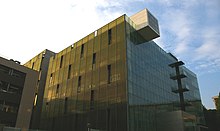Ryōji Noyori
Ryōji Noyori | |
|---|---|
 Noyori in 2013 | |
| Born | September 3, 1938 |
| Nationality | Japanese |
| Alma mater | Kyoto University |
| Awards |
|
| Scientific career | |
| Fields |
|
| Institutions | |
Elias J. Corey | |
| Website | www |
Ryōji Noyori (野依 良治, Noyori Ryōji, born September 3, 1938) is a Japanese
Education and career
Ryōji Noyori was born in
Research



(in Nagoya University)

Noyori believes strongly in the power of catalysis and of green chemistry; in a 2005 article he argued for the pursuit of "practical elegance in synthesis".[11] In this article he stated that "our ability to devise straightforward and practical chemical syntheses is indispensable to the survival of our species." Elsewhere he has said that "Research is for nations and mankind, not for researchers themselves." He encourages scientists to be politically active: "Researchers must spur public opinions and government policies toward constructing the sustainable society in the 21st century."[12]
Noyori is currently a chairman of the Education Rebuilding Council, which was set up by Japan's PM
Noyori is most famous for
He has also worked on other

More recently with Philip G. Jessop, Noyori has developed an industrial process for the manufacture of N,N-dimethylformamide from hydrogen, dimethylamine and supercritical carbon dioxide in the presence of RuCl2(P(CH3)3)4 as catalyst.[15]
Recognition
He has also been awarded:
- 1978 – Matsunaga prize
- 1982 – Chu-Nichi Culture Award
- 1985 – The Chemical Society of Japan Award
- 1991 – John G. Kirkwood Award, American Chemical Society and Yale University
- 1992 – Asahi Prize
- 1993 – Tetrahedron Prize
- 1995 – Japan Academy Prize (academics)
- 1997 – Arthur C. Cope Award
- 1997 – Chirality Medal
- 1999 – King Faisal International Prize
- 2001 – Wolf Prize in Chemistry
- 2001 – Nobel Prize for Chemistry
- 2009 – Lomonosov Gold Medal
See also
- List of Japanese Nobel laureates
- List of Nobel laureates affiliated with Kyoto University
References
- ^ a b "Fellowship of the Royal Society 1660–2015". Royal Society. Archived from the original on October 15, 2015.
- ^ Organic synthesis in Japan : past, present, and future : in commemoration of the 50th anniversary of the Society of Synthetic Organic Chemistry, Japan / editor in chief, Ryoji Noyori (1992)
- ^ Asymmetric catalysis in organic synthesis (1994)
- ^ T. J. Colacot. "2001 Nobel Prize in Chemistry". Platinum Metals Review 2002, 46(2), 82–83.
- ^ Ryoji Noyori Nobel lecture (2001)
- ^ Ryoji Noyori Nobel lecture video (2001)
- ^ Autobiography
- ^ Biographical snapshots: Ryoji Noyori, Journal of Chemical Education web site.
- ^ Ryoji Noyori – website Nagoya University
- ^ RIKEN News March 24, 2015 [1], Nature News March 24, 2015 [2]
- PMID 15795753.
- ^ Keynote address, June 23, 2005, at the Second International Conference on Green and Sustainable Chemistry, Washington DC.
- ^ Abe panel wants kids in class more, plus harsher discipline | The Japan Times Online. Search.japantimes.co.jp (January 20, 2007). Retrieved on 2011-06-27.
- ^ Japan: Takasago to Expand L-Menthol Production in Iwata Plant. FlexNews. January 10, 2008
- ISBN 978-3-527-29605-7. Retrieved June 27, 2011.
- ^ (in French) Ryoji Noyori, honorary doctorate awarded Nobel Prize Archived March 26, 2009, at the Wayback Machine, Rennes1 campus, November–December 2001
External links
- Ryōji Noyori on Nobelprize.org including the Nobel Lecture December 8, 2001 Asymmetric Catalysis: Science and Technology

